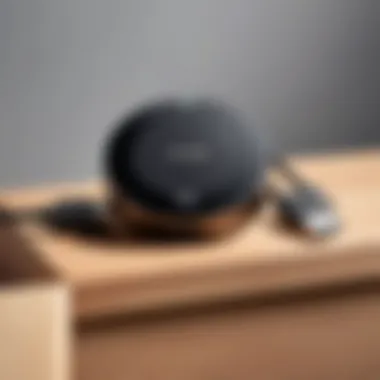Troubleshooting Prime Video Chromecast Issues Effectively


Intro
As streaming services continue to evolve, the demand for seamless integration between devices becomes increasingly important. Prime Video, with its extensive library, attracts many viewers who wish to enjoy content on larger screens using Chromecast. However, various complications can arise during the casting process, often stemming from technical glitches or settings that need adjusting. This article seeks to demystify these hurdles, targetting tech enthusiasts and IT professionals looking for effective solutions to restore smooth viewing experiences. Understanding the common issues faced with Prime Video on Chromecast can help in navigating the technical maze.
Overview of Hardware/Software
When dealing with devices such as Chromecast, it's crucial to set the stage with a brief description of its functionality and features. Chromecast, developed by Google, allows users to stream content from mobile devices or computers directly to a television. The device largely operates through Wi-Fi connectivity and supports various streaming services, including Prime Video.
Key Features and Specifications
- Device Compatibility: Chromecast works with multiple operating systems including Android and iOS, as well as desktop systems like Windows and macOS.
- Resolution Support: Depending on the model, Chromecast supports up to 4K resolution, catering to different user needs.
- HDMI Connection: An HDMI port is essential to link Chromecast to any television, making it user-friendly for most setups.
Pricing and Availability
Chromecast is widely available at most electronics retailers, both in physical stores and online marketplaces. Pricing varies by model: the standard model, Chromecast with Google TV, typically retails for around $49.99, while the Ultra 4K version can reach up to $69.99.
Comparison to Previous Models
The leap from Chromecast 1st generation to the latest version saw improvements in performance, user interface, and additional features, such as voice control capabilities and an added remote. The earlier versions lacked some of the intuitive elements that now make casting from Prime Video a breeze—untangling some past streaming woes.
Pros and Cons
Strengths
- Versatile Streaming: Supports various apps, including Prime Video, Netflix, and YouTube.
- Easy Installation: Setting it up is straightforward; plug it in, connect to Wi-Fi, and cast away.
- Affordable: Compared to other streaming devices, Chromecast provides a cost-effective option for enhancing your viewing experience.
Weaknesses
- Wi-Fi Dependent: If the Wi-Fi connection is unstable, streaming quality may suffer, leading to frustrating interruptions.
- Limited Standalone Features: Chromecast requires a separate device to cast content, unlike other devices that have built-in apps.
User feedback often highlights connectivity issues as a significant drawback, particularly when attempting to stream from the Prime Video app.
Performance and User Experience
In terms of performance, Chromecast has garnered mixed reviews. The device is generally reliable; however, performance can fluctuate based on network conditions.
Real-World Usage Scenarios
During peak usage times or in households with multiple devices connected to the same network, users might notice buffering or lag. For instance, one common instance is when a family member starts a video conference while someone else is streaming Prime Video; both tasks may experience interference.
User Interface and Ease of Use
Navigating through the Chromecast interface has improved, especially with the addition of Google TV. Yet, some users still report the need for updates to app integration, citing that procedures for launching Prime Video casting aren’t always intuitive.
Recommendations and Epilogue
Addressing the challenges associated with Prime Video casting to Chromecast requires an understanding of both technology and user behavior. Evaluating your home network setup can often lead to significant improvements in streaming performance. For IT professionals or tech enthusiasts, ensuring a solid Wi-Fi connection and keeping apps updated can mitigate many common issues.
When investing in a streaming device like Chromecast, it’s important to consider the needs of the target audience: whether they're tech-savvy individuals looking for cost-effective solutions or families who desire seamless streaming. Ultimately, as streaming technology continues to progress, resolving these common hiccups will fine-tune the overall viewing experience.
Understanding Chromecast Functionality
In the rapidly evolving landscape of digital entertainment, understanding how Chromecast works is crucial for anyone looking to optimize their experience with streaming services like Prime Video. Chromecast acts as a bridge between your devices and your television, providing a seamless way to stream content directly from your phone, tablet, or computer. This functionality not only enhances convenience but also opens the door to a wealth of content, making it essential for both casual viewers and tech aficionados alike.
Overview of Chromecast Technology
Chromecast is a small device that plugs into the HDMI port of your TV and connects to your home Wi-Fi network. Utilizing Google Cast technology, it allows users to cast content from compatible apps on their devices directly onto their television screen. When you cast a video, the Chromecast retrieves it directly from the internet, relieving your device from the strain of rendering video content. The setup process is straightforward, involving connecting your device to Wi-Fi and installing the Google Home app to manage settings. This technology is user-friendly, but understanding its nuances can help mitigate technical glitches later.
Compatibility with Streaming Services
Not every streaming service seamlessly integrates with Chromecast. While big names like Netflix, YouTube, and of course, Prime Video support this technology, some services still lag behind. It's pivotal to check the compatibility of your desired app. Moreover, updates to these apps might alter their casting capabilities, which could lead to unexpected hiccups during usage. Therefore, being aware of which services work best with Chromecast enhances the overall streaming experience.
Common Uses of Chromecast
Chromecast is not strictly for streaming movies and shows. Its versatility is one of its strongest suits. Users can cast presentations from Google Slides, mirror their device's screen for gaming, or even use it to play music through various streaming apps. The potential applications are vast, making it a valuable tool in various scenarios. Additionally, for individuals who frequently host gatherings, casting a shared playlist or a live event can create a more engaging atmosphere among friends and family.
"With Chromecast, the frontier of viewing flexibility is just a click away, allowing users to curate their entertainment without being anchored to one device."
Understanding these facets of Chromecast functionality lays the foundation for a smoother experience with Prime Video and other streaming services. Whether you're troubleshooting connection errors or optimizing settings for the best viewing experience, a solid grasp of Chromecast tech will serve you well.
Prime Video on Chromecast: A Quick Guide
Casting Prime Video to a Chromecast is like opening a door to a world of entertainment right in your living room. This section is crucial as it tackles the nitty-gritty of getting started with Prime Video on Chromecast. It lays the groundwork for a seamless streaming experience, ensuring that users can enjoy Marvel flicks or binge-watch their favorite shows without any hiccups. Here, we will discuss the essentials that make this experience enjoyable, highlighting what to consider before diving into your favorite content.
Initial Setup Requirements
Getting everything set up correctly is your first step. Before casting, make sure to have these in line:
- Chromecast Device: It's essential to have the device plugged into the HDMI port of your TV. If your TV does not support HDMI, you might need an adapter.
- Wi-Fi Connection: Both your Chromecast and the device from which you are casting must be on the same Wi-Fi network. The Wi-Fi strength matters; a weak signal could lead to sluggish streaming.
- Prime Video Subscription: Ensure your account is active. You wouldn’t want to be left scratching your head when trying to access content.
- Updated Apps: Check app versions on your mobile or web browser. Older versions might not support the latest casting features.
Setting up these components right can prevent a lot of headaches down the line, so take the time to double-check everything.


Accessing Prime Video
Now, let’s talk about jumping into Prime Video. If you've met the initial requirements, accessing the app is pretty straightforward. You can do it from:
- Smartphone: Launch the Prime Video app on your Android or iOS device. Sign in using your Amazon credentials, and you’re set to go.
- Web Browser: Open any popular web browser and navigate to the Prime Video website. Signing in is just as simple as on mobile.
Once logged in, scroll through the library. It’s an enticing catalog, with everything from blockbuster movies to original series. Selecting what you wish to watch is as simple as tapping a few icons.
Pro Tip: Make use of the search feature to quickly find specific titles. Typing the movie or show name saves time, ensuring you spend more time enjoying, not hunting.
Casting from Mobile and Desktop
Casting differs slightly depending on whether you’re using a mobile device or a desktop. Here’s how:
From Mobile Device
- Open the Prime Video App: Once you’re in, locate the cast icon – it usually looks like a rectangle with a Wi-Fi symbol in the corner.
- Select Your Chromecast: You’ll see your Chromecast listed among devices. Tap on it.
- Choose Content to Cast: After connecting, select the movie or show you want to watch, hit play, and you’ll see it on your TV instantly.
From Desktop
- Browser Setup: Ensure your computer’s Chrome browser is up to date. Access the Prime Video website and sign in.
- Cast from Browser: Click on the three dots at the top right corner of your browser, and select "Cast" from the dropdown menu. Then, click on your Chromecast device.
- Watch with Ease: Once your device connects, it will enable casting directly from your browser to your TV.
Choosing the right casting method can improve your streaming experience significantly, tailoring it to whichever device suits your workflow better. Regardless of your approach, the integration is designed to be intuitive, getting you aligned with the digital entertainment world smoothly.
Identifying Common Problems
Identifying common problems is a crucial step in effectively troubleshooting issues encountered while using Prime Video on Chromecast. Before diving into solutions, understanding the nature of the problems can make a significant difference in achieving a streamlined viewing experience. Recognizing the usual roadblocks can save both time and frustration, as many users face similar challenges when attempting to cast content.
For tech enthusiasts and IT professionals alike, the ability to pinpoint the specific difficulties is akin to having a blueprint for the solution. Each of the common problems outlined below represents not just a potential hindrance but also an opportunity for a quick fix. The following subsections shed light on areas that frequently trip users up:
- Connecting your device seamlessly, ensuring all parts of the tech puzzle fit together.
- Maintaining the harmony between audio and visuals, so viewers are not left in a confusion.
- Addressing connectivity issues that can sour the experience significantly.
Understanding these issues in detail provides a strategic advantage, ensuring users are prepared to tackle challenges head-on.
Casting Not Responding
One of the most common frustrations encountered when attempting to cast Prime Video content is when the casting function appears to be non-responsive. This situation can often leave users scratching their heads and wondering where things went wrong.
When you click the cast icon, nothing happens, or it simply spins in circles, indicating that the Chromecast cannot establish a connection. This can stem from various issues:
- Device Compatibility: Not all devices are compatible with Chromecast, and running an outdated version can prevent successful casting.
- Network Glitches: If the Wi-Fi connection is shaky or drops altogether, it can disrupt the connection to your Chromecast.
- App Glitches: Sometimes, the app itself may encounter errors, causing casting to freeze up.
To troubleshoot this, try restarting both the casting device and the Chromecast. If that doesn't work, ensure both devices are connected to the same Wi-Fi network and that the app is up to date. This minor step often does wonders and can get the show back on the road.
Audio and Video Sync Issues
There's nothing quite as jarring as the dreaded audio and video sync problem. Imagine watching your favorite movie, and the character’s voice lags behind their lips moving—it's like watching a poorly dubbed foreign film. This kind of annoyance can seriously detract from the viewing experience.
The factors contributing to sync issues usually include:
- Network Latency: A slow connection can cause delays in data transmission, leading to a mismatch.
- Device Performance: Older devices may struggle to process streaming efficiently, while newer devices typically perform better.
- Settings Misconfigurations: Improper audio/video settings can sometimes lead to these discrepancies.
To resolve this problem, start by checking your internet speed. You might also need to explore settings on the casting device or within the Prime Video app itself. Sometimes, toggling the settings or adjusting the resolution can resolve these frustrating sync issues.
Connection Errors
Connection errors are the bane of every streamer’s existence. Whether it's a message stating "Chromecast not found" or the frustrating reality that your device can't communicate with the internet, these errors can pop up unexpectedly.
Key factors that often lead to connection errors include:
- Wi-Fi Range: Chromecast relies on a strong Wi-Fi signal, and if you're too far from your router, you might lose connection.
- Router Congestion: Too many devices connected to a single router can lead to bandwidth issues.
- Firewall Settings: Sometimes, your router settings can block the necessary ports that Chromecast needs to function.
Fixing these errors usually requires checking the integrity of the Wi-Fi connection and ensuring that the router is up to snuff. Restarting your router could remedy connection hiccups, allowing everything to communicate better. If problems persist, it may be worth delving into router settings to diagnose the issue further.
Important Note: Keeping your Chromecast firmware and the Prime Video app updated can often prevent these common problems. Be proactive about your tech health!
Troubleshooting Techniques
In the world of streaming, not every experience is smooth sailing. When it comes to using Prime Video with Chromecast, unforeseen issues can often arise, leaving users feeling a bit frustrated. This section tackles the key techniques that can aid in resolving common problems, making the journey of troubleshooting a less daunting one. Techniques like restarting devices, checking network settings, and updating software may sound simple on the surface, but they carry significant weight in correcting and optimizing streaming performance. Understanding these methods not only enhances individual problem-solving skills but also fosters a clearer insight into compatibility and connectivity—elements critical for seamless streaming.
Restarting Devices
One of the most frequently overlooked solutions is the simple act of restarting devices. Whether you're dealing with a stubborn Chromecast or a temperamental smartphone, turning devices off and back on again serves as a reset button for many technical issues. When a device is powered off, it provides an opportunity for internal caches and memory to clear out operations that might be creating conflicts. So, if casting isn't responsind as it should or if an app refuses to load, go ahead and give those gadgets a fresh start.
- Chromecast Restart: Unplug your Chromecast from the power source and wait about 10 seconds before plugging it back in. Once it powers back up, attempt the connection again.
- Device Restart: Similarly, try restarting the devices that you use to cast—be it a smartphone, tablet, or computer. The reboot process can clear temporary glitches that might be hindering your streaming experience.
Checking Network Settings
A substantial amount of streaming issues stem from poor network performance. Delving into network settings can unveil hidden culprits behind the streaming woes. Ensuring that your device is connected to the right Wi-Fi network is paramount for effective casting. Here's a checklist:
- Wi-Fi Connection: Confirm that both the Chromecast and the casting device are connected to the same Wi-Fi network. Network discrepancies can easily lead to connection failures.
- Router Configuration: A well-configured router can significantly enhance your streaming experience. Factors like network frequency (2.4GHz vs. 5GHz) and security settings play a part. For example, using the 5GHz band generally provides faster speeds but has less range compared to 2.4GHz.
- Device Permissions: Some casting issues may arise from app permissions. Make sure that the Prime Video app and any other necessary applications have the necessary permissions to access the network.
Regularly checking these settings can save users from a lot of headaches.


Updating Software and Apps
Staying up-to-date is crucial, especially for apps and systems that connect and interact with other devices. Software updates often contain important fixes that can enhance compatibility and performance.
For Prime Video, it's important to check the following:
- App Updates: Ensure that the Prime Video app is the latest version. Go to the app store on your device, search for Prime Video, and see if an update is available.
- Chromecast Updates: Check if your Chromecast has the latest firmware. The device usually updates automatically, but if there’s an issue, a factory reset could trigger the update process.
- Operating System Updates: Finally, keep your smartphone or computer’s operating system updated. Compatibility between apps and devices can often touch upon outdated operating systems.
Taking the initiative to update devices and applications not only helps smooth out existing issues but also preemptively reduces the likelihood of new ones sprouting up in the future.
Ensuring Optimal Connectivity
Ensuring optimal connectivity when streaming Prime Video on Chromecast is central to achieving a seamless viewing experience. Without a solid connection, even the most compelling shows can turn into pixelated messes or, worse, leave you stuck buffering. Here, we’ll explore the critical elements of ensuring a robust connection, focusing on three main areas: evaluating Wi-Fi network performance, router placement considerations, and the potential benefits of using Ethernet adapters.
Evaluating Wi-Fi Network Performance
Before diving headlong into troubleshooting, it’s essential to evaluate the performance of your Wi-Fi network. The strength and speed of your connection significantly affect how well you can stream content. Here’s how you can assess your Wi-Fi:
- Use Speed Test Tools: Tools like Speedtest by Ookla can provide you with a clear picture of your internet speed. Aim for a minimum of 25 Mbps for HD streaming; slower speeds can spoil your viewing.
- Check Signal Strength: Stand close to your router and see the speed you get. If the connection drops significantly when you move away, you might have a weak signal.
- Monitor Network Congestion: During peak hours, if multiple devices are simultaneously using the network, your bandwidth may drop. Consider lesser-used times for streaming, or invest in a router that handles multiple connections effectively.
The faster your internet connection, the fewer issues you’ll face during streaming.
Router Placement Considerations
The placement of your router plays a crucial role in connectivity. A poorly placed router can block signals and create dead zones in your home. Here are a few pointers to consider:
- Central Location: Position your router centrally within your living space. This can help distribute the Wi-Fi signal more evenly.
- Elevated Position: Keeping your router on a shelf or mounted high helps avoid obstacles like furniture that can obstruct signals.
- Away from Interference: Microwaves, cordless phones, and Bluetooth devices can interfere with Wi-Fi signals. Keep your router away from these appliances.
Using Ethernet Adapters
In instances where Wi-Fi connectivity continues to pose challenges, you might consider bypassing it altogether. Ethernet adapters, like the Google Chromecast Ethernet Adapter, can provide a stable connection. Here's why they can be beneficial:
- Direct Connection: Connecting your Chromecast directly to the router with an Ethernet cable eliminates interference and provides a stable internet connection.
- Consistent Speeds: Wired connections typically offer faster, more reliable speeds, so buffering issues are less likely.
- Ideal for High-Demand Streaming: For families or households with multiple devices, Ethernet can ensure that your Chromecast gets the bandwidth it needs when you’re streaming that much-awaited blockbuster.
Ensuring optimal connectivity involves paying attention to a variety of factors. By evaluating the network performance, positioning your router wisely, and considering the advantages of a wired connection, you can significantly enhance your streaming experience with Prime Video on Chromecast.
Application-Specific Considerations
When considering the interaction between Prime Video and Chromecast, application-specific issues frequently emerge as significant hurdles. These challenges can often stem from the unique nature of the Prime Video app itself. Understanding this part is essential for anyone wanting to enjoy their favorite shows or movies without interruptions. Here, we delve into several facets, including app version issues, potential account-related troubles, and geographic limitations.
Prime Video App Version Issues
The version of the Prime Video app on your device plays a crucial role in casting functionality. If you’re working with an outdated version, glitches may pop up like popcorn in a hot pan. This doesn't just interfere with playback; it can severely restrict features like casting altogether.
Regular updates often come with important bug fixes, performance enhancements, and even new streaming features. To evade those headaches, check the app's version and make sure it’s up to date. Here's how:
- Open the app store on your device.
- Search for Prime Video.
- Select the app and click on ‘Update’ if it’s available.
Outdated apps hardly ever play nice, so keeping yours fresh is a smart move—like a stitch in time saves nine.
Account and Subscription Problems
Sometimes, the devil lies in the details of your Prime Video account settings. A problem with your subscription can be the root cause of many issues. If you're signed out or your subscription has lapsed, streaming won’t work as smooth as butter.
Ensure your account is in good standing:
- Confirm that your subscription is active.
- Check for any payment issues or expired cards.
Logging out and back in can also work wonders, clearing up any session-based quirks. Think of it as a quick reboot for your streaming experience.
Geographic Restrictions
Geographic restrictions can feel like hitting a brick wall when you’re excited to binge-watch a series. Content availability is often bound by licensing agreements that vary from country to country. If you find that certain titles are grayed out, this is mostly due to these restrictions.
To mitigate frustration, consider the following:
- Check Prime Video’s library in your region to understand available content.
- If you’re traveling, use a VPN cautiously, but be mindful of terms with your subscription to avoid potential breaches.
Having insight into these restrictions can save you more than just time—it can help maintain your sanity while streaming.
Important Note: Before assuming your problems with Chromecast and Prime Video are due to technical issues, always look into these application-specific matters. They can often lead you directly to the root cause.
Device-Specific Troubleshooting
Navigating the world of streaming can sometimes feel like trying to find your way around a maze with no map. Let's be real: different devices often bring their own set of quirks and issues, which makes device-specific troubleshooting a crucial part of optimizing your Prime Video experience via Chromecast. IT professionals and tech enthusiasts alike benefit from understanding these nuances. This section sheds light on the tangible elements, advantages, and considerations that shape effective troubleshooting through the lens of specific devices.
Chromecast Models and Their Differences
Understanding which Chromecast model you are using can dramatically influence your troubleshooting efforts. Each model comes with distinct features and software capabilities. The original Chromecast, Chromecast 2, and the Chromecast Ultra all have their pros and cons.
- Original Chromecast: This was the pioneer of streaming using HDMI; however, it has limited hardware specs and might struggle with high-definition content.
- Chromecast 2: An upgraded version with better Wi-Fi range, making it less likely to drop connections during casts, which is paramount for smooth viewing experiences.
- Chromecast Ultra: A game changer for more demanding users, it allows for 4K streaming, yet its higher power usage might cause certain issues if not properly addressed.


When troubleshooting, knowing your model aids you in identifying whether the problem lies with the streaming compatibility or the device’s performance capabilities. For instance, trying to stream 4K content through the original Chromecast is like expecting a tortoise to win a race against a rabbit—it's simply not equipped for it!
Resolving Issues on Specific Devices
Different devices may offer different experiences with Chromecast and Prime Video, leading to some head-scratching moments. If you own a Pixel 4a and a Samsung Galaxy S21, but find that only one successfully casts Prime Video without hiccups, here's how to approach the resolution based on specific device features:
- Android Devices: Ensure that the Prime Video app is updated. Sometimes, compatibility issues arise from incompatibilities between older app versions and newer OS features. A simple app update could save you from a world of trouble.
- iOS Devices: If you’re casting from an iPad, keep in mind that network permissions differ from Android. Make sure that the app has permission to use local network data.
- Tip: You might revisit iOS settings to toggle the Prime Video app access on and off to kickstart connectivity.
- Windows and MacOS: For desktop users operating through Google Chrome, clear your browser cache. Sometimes, conflicting cache data can hinder image and sound, making your viewing less enjoyable.
- Example: If your Pixel 4a is having issues, check your app version against the Google Play Store’s version.
- Quick Fix: Go to Settings > Privacy and Security > Clear Browsing Data in Chrome and ensure data from the last week is cleared for smooth streaming again.
In the end, device-specific troubleshooting isn't just about fixing a glitch; it's about understanding how to leverage the unique capabilities and limitations of your gadgets to streamline your streaming experience.
"Knowledge is power; understanding your equipment's idiosyncrasies can be the difference between a few clicks and an all-night tech struggle."
By taking the time to weigh the differences between your devices and approaching the troubleshooting process with a tailored mindset, you can transform what could be a frustrating experience into something far more seamless. Armed with this knowledge, you can confront any Chromecast challenge like a seasoned pro.
When All Else Fails
As the saying goes, when push comes to shove, it’s crucial to know your last-ditch efforts when all else seems to go south. In the realm of streaming Prime Video on Chromecast, there may come a time when you've tried all the usual fixes and nothing seems to work. This section emphasizes the essential steps you can take to regain control of your viewing experience. Here, we will explore three significant avenues: factory resetting your Chromecast, contacting customer support, and considering alternative streaming solutions. Each of these options serves as a lifeline, enabling you to troubleshoot effectively when the standard procedures fall short.
Factory Resetting Chromecast
A factory reset can sound pretty scary, especially if you’ve grown attached to your settings. However, it can clear up underlying problems that just won’t budge with simple reboots or network tweaks. When performing a factory reset, you’re wiping the slate clean, which can often resolve persistent issues. This method restores your Chromecast to its original settings, removing all saved data, including combined connections.
Steps to Perform a Factory Reset:
- Long press the button on your Chromecast device for about 25 seconds.
- Wait for the LED light to start blinking orange, and then release the button.
- The LED will eventually blink white, indicating that the reset is complete.
This could be your best shot if your device is stuck in a loop or behaving erratically. Don't dismiss it; many find that their streaming issues vanish like dust in the wind after this step.
Contacting Customer Support
After exhausting all standard troubleshooting, reaching out to customer support can feel like the proverbial Hail Mary. If your Chromecast has suddenly decided to give you the silent treatment with Prime Video, don’t hesitate to use those support hotlines. There’s a chance you might bump into someone who's seen it all before, and they may have solutions tailored to your specific predicament.
What to Keep in Mind Before Calling:
- Have your Chromecast model and software version handy.
- Be ready to explain the specific problem and the steps you’ve already tried.
- Ask questions about warranty or replacement if the unit appears faulty.
A well-prepared conversation can save time and yield fruitful results, potentially getting your streaming back on track in a jiffy.
Exploring Alternative Streaming Solutions
Sometimes the quickest way to solve a problem is to pivot—if you can’t get Prime Video to cooperate, perhaps exploring alternative streaming solutions might be the ticket. While streaming services are not all built the same, several applications cater to various entertainment needs and can be just as enjoyable. Solutions can include using other platforms or connecting different devices for streaming.
Possible Alternatives You Might Consider:
- Netflix for its vast library of content.
- Hulu, which offers a different mix of shows and movies.
- YouTube, where you’ll find tons of user-generated content.
This approach allows you to keep the entertainment flowing, ensuring you're not left twiddling your thumbs while sorting out your Prime Video issues. It's like not throwing in the towel while keeping your options open.
Future Outlook for Streaming Technologies
As we look ahead in this rapidly evolving digital landscape, understanding the future outlook for streaming technologies takes center stage. This is particularly relevant for tackling the issues faced when using Prime Video with Chromecast. The problems encountered today are often symptoms of larger changes within tech ecosystems. By identifying upcoming trends, IT professionals and tech enthusiasts alike can navigate potential challenges with foresight and agility.
Streaming technologies are not just about content delivery; they embody a myriad of evolving systems designed for an improved user experience. The future promises advancements not only in speed but also in efficiency and integration across devices.
Trends in Streaming Services
- Diverse Content Delivery: Streaming services are diversifying their offerings. From exclusive shows on Prime Video to live sports, there's a broader competition for viewer attention. This diversity inadvertently leads to compatibility and usability challenges.
- Enhanced User Experience: User interfaces are expected to become even more seamless, thus requiring continual updates in connected devices to ensure flawless streaming. Imagine navigating through content with voice commands that are faster and smarter.
- Adoption of 5G Technology: The rollout of 5G networks is set to revolutionize streaming by facilitating higher resolutions, faster buffering times, and live streaming experiences that could potentially eliminate lag.
- Integration of AI: Artificial intelligence is on the verge of personalizing streaming experiences, predictive content algorithms could enhance viewing habits, leading to surprising issues when old technology can't keep up with new functionalities.
Improving Compatibility and Performance
The drive for better compatibility among streaming technologies may be the linchpin in troubleshooting issues like those often faced with Prime Video on Chromecast. Here are some key considerations:
- Cross-Platform Compatibility: As devices become more interconnected, ensuring that all your devices—smart TVs, mobiles, tablets—work harmoniously with Chromecast will be essential. Constant updates may be needed to maintain this compatibility.
- Software Enhancements: Regular updates to both the Chromecast firmware and the apps themselves play a pivotal role in minimizing performance hiccups. Users should be diligent about installing those updates to benefit from the latest features.
- User Feedback Loops: Developers often depend on user feedback for enhancing compatibility. Reporting bugs and issues directly can lead to quicker fixes, ensuring that services run smoothly and efficiently.
"Looking forward, the impacts of emerging technologies on streaming will be vast and far-reaching, potentially transforming how we consume media.”
All in all, keeping a lookout on the developments in streaming technologies arms users with the necessary tools to troubleshoot Prime Video Chromecast issues effectively. Understanding these upcoming trends and enhancing compatibility is not just about avoiding pitfalls, but also about embracing possibilities for a richer viewing experience.
Ending
When it comes to troubleshooting Prime Video issues on Chromecast, a systematic approach is vital. Understanding the nuances of both devices and their interactions can prevent unnecessary headaches. As streaming technology continues to evolve, recognizing the potential pitfalls in connectivity and application performance can make a substantial difference to your viewing experience.
Navigating through considerations such as network stability, device compatibility, and app functionality puts you in a position of power. Not only does it allow a smooth streaming journey, but it also enhances the overall enjoyment of using Prime Video. Every moment of frustration with buffering or disconnecting can sour the experience. Thus, effective troubleshooting is not just about fixing what's broken; it's about preserving the joy of content consumption.
"Knowledge is power, especially in the tech world—understanding how Chromecast and Prime Video can seamlessly work together gives you the upper hand."
In summary, the key points discussed in this article facilitate an informed and proactive approach to streaming issues. Employing straightforward techniques can often lead to quick solutions and, crucially, enhance your overall experience.
Recap of Key Points
- Understanding Chromecast features is crucial for effective troubleshooting.
- Identifying common problems such as connectivity or audio-visual sync can streamline your efforts.
- Using solid troubleshooting techniques—like device restarts and network checks—can quickly remedy many issues.
- Awareness of app-specific considerations offers a strategic advantage in pinpointing problems.
- Device-specific troubleshooting is essential for targeted solutions based on your particular setup.
Final Thoughts on Avoiding Issues
To prevent frustrations in the future, consider routine checks on your streaming setup. Update the Prime Video app regularly, maintain a solid Wi-Fi connection, and ensure your Chromecast firmware is up to date. Keeping tabs on these elements can significantly lower the chances of encountering issues. Moreover, exploring alternative streaming solutions can serve as a backup plan, ensuring that your viewing experience remains uninterrupted. A bit of preventative care goes a long way, saving time and ensuring a smoother entertainment journey.



